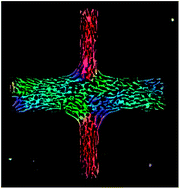Perfect nematic order in confined monolayers of spindle-shaped cells†
Abstract
Elongated, weakly interacting, apolar, fibroblast cells (mouse fibroblasts NIH-3T3) cultured at confluence align together, forming large domains (correlation length ∼ 500 μm) where they are perfectly ordered. We study the emergence of this mesoscopic nematic order by quantifying the ordering dynamics in a two-dimensional tissue. Cells are initially very motile and the monolayer is characterized by anomalous density fluctuations, a signature of far-from-equilibrium systems. As the cell density increases because of proliferation, the cells align with each other forming these large oriented domains while, at the same time, the cellular movements and the density fluctuations freeze. Topological defects that are characteristic of nematic phases remain trapped at long times thereby preventing the development of infinite domains. When confined within adhesive stripes of given widths (from 30 μm to 1.5 mm) cells spontaneously align with the domain edges. This orientation then propagates toward the pattern center. For widths smaller than the orientation correlation length, cells perfectly align in the direction of the stripe. Experiments performed in cross-shaped patterns show that in the situation of two competing populations, both the number of cells and the degree of alignment impact the final orientation.

- This article is part of the themed collection: Proteins, cells, and tissues in patterned environments

 Please wait while we load your content...
Please wait while we load your content...